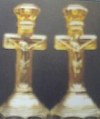A Step Away From The Usual
A STEP AWAY FROM THE USUAL
Part of the fun in collecting is the discovery (every once in awhile) that an item is somewhat unusual. This segment will delve into that area just a bit. We're not talking about high priced rarities here; just “priceless” rarities! That's provided you can locate one of them! As a matter of fact, perhaps some collectors might refer to such as these as “so who cares?” That's fine. If the pictures look interesting, then come on along. There are human interest stories to go with, which are worth a fortune; if not in money, then certainly in time!
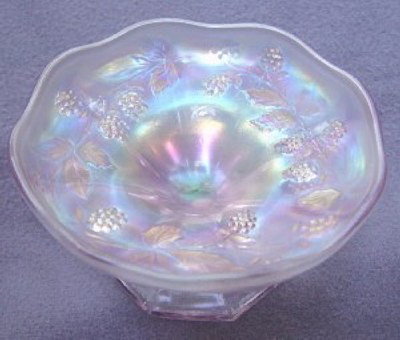
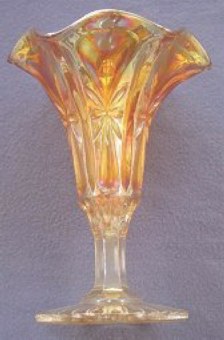
Miniature Blackberry and Propeller Vase
With Fenton Miniature Blackberry compotes available in amethyst/purple, blue, green, marigold and white, you must agree that the “oddball” color of the one shown would “make your heart sing”, when after the respected, late John Britt and Frank M. Fenton examined the piece, they both agreed that it was NOT sun-turned, because the iridescence was not altered in any way. Frank's conclusion: ORCHID was a standard base color of that time period. Where are the others, IF there was a half turn made? Perhaps the Blackberry mold was used by a worker at the end of a shift when orchid glass was in the vat being used for some other production run. We purchased the compote from a collection being disposed of in Fallbrook, CA during the late `80's, while we still lived in San Diego. We have never seen another like it in the years since. There is tri-corner, flattened plate, and rather sherbet-type shapes known in the usual color range.
Propeller Vase is 7 ½” tall. The same name applies to the short stemmed versions called Propeller compotes which are about the size of the Min. Blackberry compotes. The carnival production for these vases was apparently limited. These are seldom seen, and all are marigold. The shape was used for Imperial pressed glass, prior to the carnival glass era. This particular one was in a convention window display back in the mid `80's. The nice gentleman in that room was Ray Reichard of PA, a longtime aficionado. I asked whether the vase was for sale. His smiling reply was, “You know how to buy Glass! You never want to buy what is set out for sale. The GOOD stuff is always in the display!” He went on to say that his wife had never liked the piece and wouldn't keep it dusted. IF I would promise to keep it dusted, he WOULD sell it to me at the conclusion of the convention. “Well, Ray, as you can see, I'm STILL dusting this beautiful vase! Some of the more expensive and “famous” vases receive more rave reviews, but for style, balance, and artistry of design, this one is not easily surpassed. It certainly deserves much more attention than it receives from collectors! One for sale recently over Ebay was scarcely noticed. Even the seller was not versed in its origin.
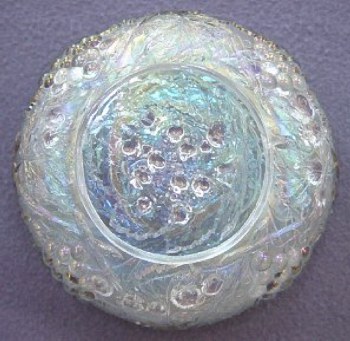
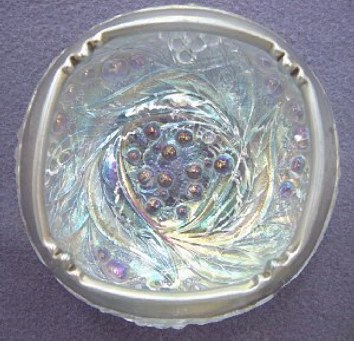
Palm Beach and Gooseberry
US Glass (recently read that this company was in business in 1891) manufactured some of the most exquisite crystal patterns prior to the Carnival era. A certain eloquence accompanies the examples of pearlized white iridized pieces, distinctly different from the other manufacturers. Much of their white has a slightly gray appearance to the base glass. Much of their marigold has an amber appearance. The two photos shown of the lovely 4 3/8” rose bowl, reveals not one iota of space without design. Replete with either a gold or silver painted edge, the Palm Beach outer design gives way to more elegance in the Gooseberry interior. This is a marvel of artistry, does not surface very often, and it does not receive the raves it should. Water sets, table sets, berry sets, and several whimsey types can be found in the Palm Beach pattern. Honey amber, marigold, and white are the colors to look for.
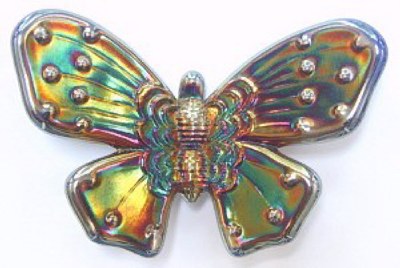
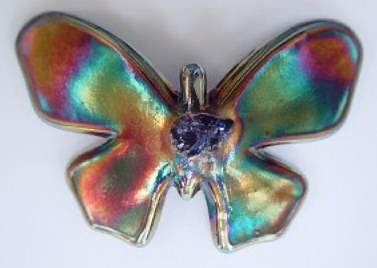
Butterfly Ornament and Reverse of Butterfly Ornament.
Somewhat difficult to ascertain, but estimates indicate fewer than 50 of these intricate Butterfly Ornaments exist. Those who take pleasure in the unusual, along with miniature collectors, revel in these somewhat delicate beauties. The wingspan on the blue one we show is but 3 ¼”. Storyline has it that these were “attached” to the handles of baskets (and such) when a Fenton purchase was made, perhaps from their gift shop. You will note the surplus glass on the underside of the ornament, bearing out the previous statement. It would have been an ideal method for furthering the interest in carnival glass. Iridized colors known are: aqua, blue, marigold, green, ice blue, ice green and white. Since this is not an item often found on carnival auction brochures, change of ownership usually takes place privately. There are no price guidelines, but reports of $900-$1150 in 1993 to $1500 in 1998 are accurate.
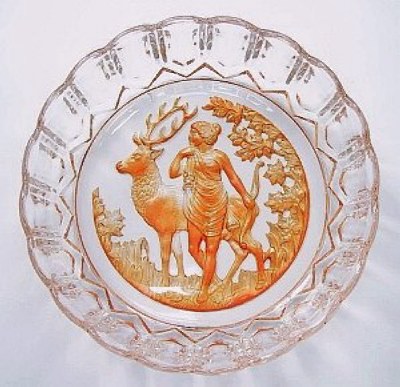
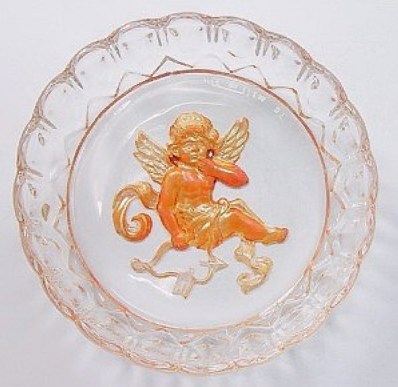
Diana the Huntress and Golden Cupid
Actual maker of this specialty glass is questionable. However, attribution has been given to Eda Glassworks of Sweden. They certainly had their own ideas about iridization when this “Golden” line of designs came to be. The patterns are “intaglio”. Many, if not most of the examples in USA came via Australia. Our Diana the Huntress 8 ¼” bowl was provided by a good friend living in Victoria. Our Golden Cupid 4 ½” bowl was purchased from the eminent Bill Edwards, of Encyclopedia fame, at the time he sold his collection in 1989. The story attached to this unusual piece: These small bowls are the accompaniment to the Diana bowl. One of the early Australian collector couples (Triplett, by name), presented some of them to collector friends in the USA, while on a visit here. Two known recipients of these lovely gifts were Grace and Byron Rinehart and Bill Edwards. Some of the glass appears to have a pink tinge, rather than being clear. Molds having straight sides were used for the Huntress and Cupid pieces.
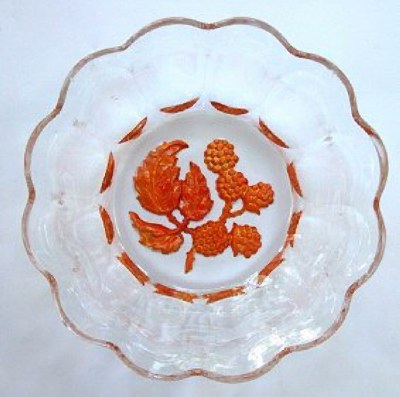
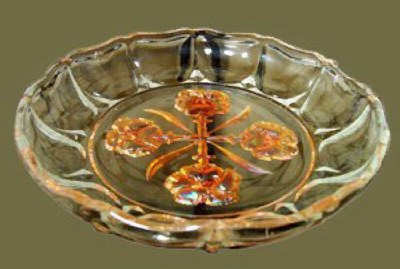
Golden Berry and Golden Pansy
Our Golden Berry 5 ½” bowl has a sloping side. John & Margaret McGrath of New South Wales, Australia wrote an article for the San Diego Newsletter in Sept. '97, about a small bowl measuring 1 ½” deep with the same straight sides as Golden Cupid, but having Golden Poppies. Their research led to Poland or Czechoslovakia as the origin. The April '98 issue of the San Diego Newsletter carried photos submitted by Richard Cinclair, of Golden Pansy and Golden Carp. Richard sent no sizes of either of these oblong trays. The Golden Pansy has four corners. The Golden Carp is oval shape. Doris Bliss of Stanton, CA provided the photo used here, showing a round 5 ½” bowl, which is part of a berry set in the Golden Pansy pattern. She bought the set over Ebay, in Aug. 2003, but in transit from Australia, the larger bowl was broken! If you know of other design examples having the golden intaglio patterns on the underside, we surely would appreciate hearing from you!
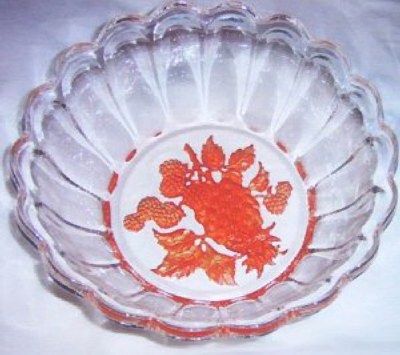
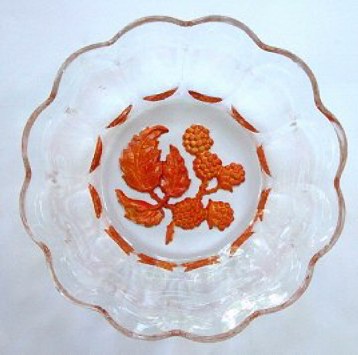
GOLDEN PINEAPPLE Just as with the Diana the Huntress master bowl, which accompanies the smaller 5 ½” Golden Cupid bowls, this Golden Pineapple and Berry master bowl accompanies the smaller Golden Berry bowl shown here.
It is an interesting facet of these Golden intaglio designs manufactured outside the USA, that they have unmatching patterns to offer.
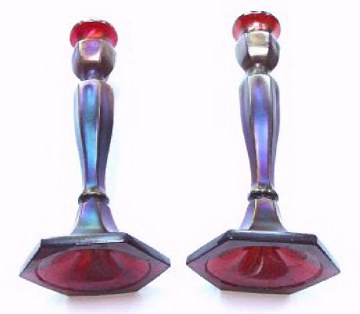
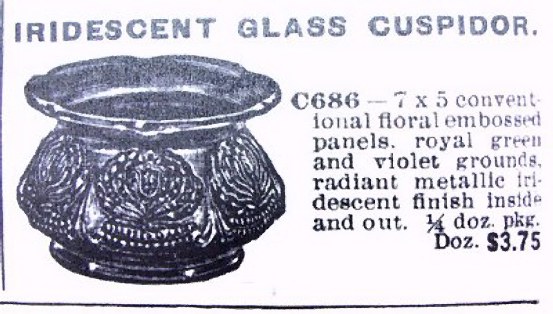
Florentine Candlesticks and spring 1912 Butler Bros. Ad.
Fenton made Florentine candlesticks in two sizes-8 ½” and 10 ½”. Certainty dictates that if you have red ones, they ARE of Fenton origin. The Northwood version is their #696 in the larger size, but we do not have the catalog # for the smaller size. The small difference in the two makes it very deceiving. Fenton used a “flair indentation” at the stem and base, whereas Northwood placed a “knob” or “ring” at the stem and base. In the strictest sense of distinction, these are in the “stretch” category. However, since time immemorial, carnival glass collectors have included them on their “want lists”. Recognized acceptability of most stretch glass pieces by carnival collectors is limited. Fenton Glass-The First Twenty-Five Years including 1921-1925, displays this design in colors of Celeste, Ice Blue, Ice Green, Olive, Vaseline, Wisteria, Topaz and Marigold and White. Celeste, Topaz, Olive and Vaseline can be found from time to time in malls and shops, Ebay, etc. However, red in either size, and the ice colors are another story entirely. Red examples in any pattern from Fenton, extending into the mid Twenties were created to extend the interest in carnival glass. We are left to assume that perhaps only a half turn-(approx. 200) or perhaps one full “turn” (approx. 400) of production took place for these more scarce candlesticks. This pair was purchased while we lived in San Diego, from a lady who no longer collects. At the time, she was quite interested in the Grape & Cable pattern and was willing to sell the candlesticks in order to purchases more of those pieces.
While exploring the unusual side(s) of carnival glass, we decided to share this Unknown Spittoon with you. (There MUST be one or more waiting to be found, out there somewhere!) Only should no orders have been placed for this piece, would production not have taken place?? Assumptions are a risky attempt to arrive at conclusion, but since the design on this oddity, is SO similar to Fenton's Thistle Banana Bowl pattern, could we dare think along those lines for derivation of this spittoon? This Spittoon is not a part of a Northwood grouping , nor any other firm's assortment, as this Spring 1912 Butler Brothers ad appears all by itself down on the lower corner of the last page in the glassware section. Isn't it a shame that this piece has never appeared in our midst?
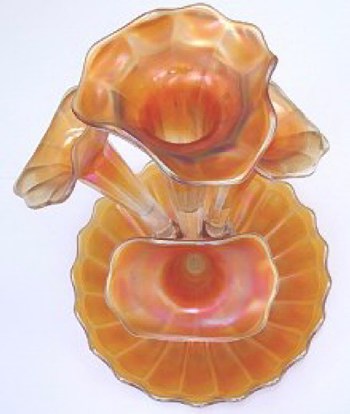
Wide Panel four lily epergne.
Few epergne designs exist in the carnival glass realm. Fenton made the small one lily example in the Vintage pattern. Dugan created the lovely Fishnet and Strawberry single lily epergnes. Northwood developed the massive Wide Panel four lily epergne for use as both a fruit and flower combination piece. The bowl portion is quite ample, and the center lily would be adequate for long stems. Unfortunately, careless handling has caused damage on many of the pieces. Once again, we are engaged in acceptance of a stretch-type iridescence so far as carnival glass collectors are concerned. These massive epergnes command attention in colors of aqua opal, blue, green, ice blue, ice green, marigold, purple and white. Green is the dominant color to be found, with marigold next in line. No matter the color your pocket book can afford, the key is to find a perfect example. That is the tricky part. Any of the colors become a treasure to hold dear. We bought this lovely marigold epergne from a local San Diego dealer, while attending an antique show. Early Sept. '03, a green Wide Panel Epergne with damage to the section holding the lilies, sold for more than $800! We have observed sale over the same venue, of a marigold example for nearly $1300!
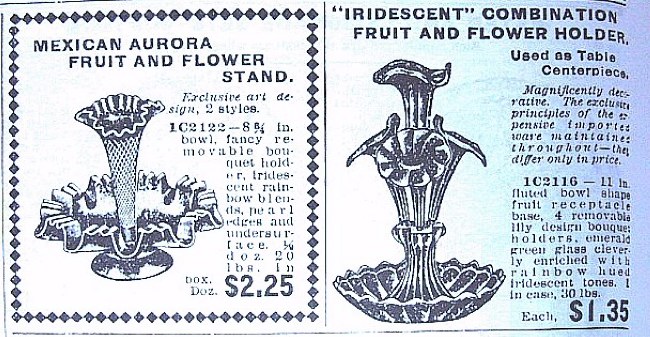
Dugan Fishnet and the Northwood Wide Panel epergnes
This 1910 Butler Brothers Catalog ad displays them in a combination marketing offer. Mexican Aurora is the Dugan Fishnet and the Northwood Wide Panel epergnes marketing term for Peach Opal. Ads of the period indicate green as the dominant color for the Wide Panel, explaining its “most common color” status today. As anyone with one of the Butler Brothers Reprint Catalogs of 1994 will verify, marketing ads for the Wide Panel Epergne appear repeatedly from one season to the next over the period from Oct. '09-June '16.
Dean & Diane Fry…9/03
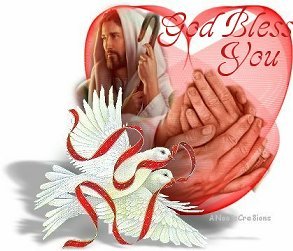
Should you care to contact the Frys, their email address is:
Search Our Sites
back to Carnival Glass 101
Our other sites you may enjoy:
Everything you EVER wanted to know about Indiana Glass
Great Reference for Newer Carnival Glass.
Complete Glassware Catalogs Available to Download
Questions? Comments? Suggestions? Broken Links? Corrections?
Your Friendly Webmaster is here to help!
